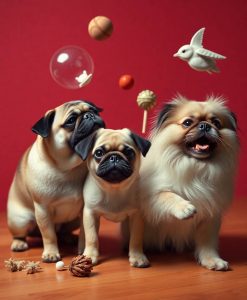Imagine holding a small, soft face that feels almost like a warm, familiar pillow. That squished, expressive face of a pug or Persian cat isn’t just adorable—it’s the result of generations of human choices, a quiet story of evolution driven by what we find most endearing. When you see a pug’s wrinkled snout or a Persian’s flattened nose, it might seem like just a cute quirk. But behind that charm lies a fascinating dance between human preference and animal biology, revealing how our deep desire for cuteness can shape the very evolution of the creatures we love.
Breeding animals for a specific look isn’t new, but recent scientific insights show that the breeds we’ve come to adore—like pugs and Persian cats—are now more similar in their skull shape than they are to their wild ancestors or even to other dog and cat breeds. This convergence in skull structure, especially the “smushed” faces, is a clear sign of how powerful our aesthetic preferences have become in directing evolution.
Why do these faces attract us so much? It’s because they evoke a sense of vulnerability and innocence—traits that instinctively trigger our nurturing instincts. When we see a face with big, round eyes and a flattened snout, our brains respond with affection, often perceiving them as more “cute” and approachable. It’s a phenomenon that has been amplified over generations, as breeders select for these features, inadvertently steering the animals’ physical evolution in a very specific direction.
This evolution is a vivid example of how human preferences are shaping the natural course of animal development, often in ways that are more similar than we might expect. The convergence of skull shape in pugs and Persian cats highlights how, despite being different species, our aesthetic ideals can create similar biological traits. It’s a reminder that the animals we cherish are, in part, a mirror of our own values and perceptions of beauty.

But what does this mean for the animals themselves? While these traits may be irresistibly adorable, they also come with health implications. Flattened faces can lead to breathing difficulties, and the structural changes in their skulls may cause other health challenges. This raises important questions about the ethics of breeding for extreme cuteness—are we sacrificing the well-being of these animals in pursuit of that perfect, cuddly appearance?
If you’ve ever wondered why your pet has such a distinct face or why certain breeds seem to have become more similar over time, this research offers a window into the subtle influence of human choice. It also invites us to reflect on how our love for certain traits can have profound effects on animal health and diversity. Recognizing that our aesthetic preferences can drive evolutionary change encourages a more mindful approach to pet breeding—one that balances beauty with health and well-being.
In a world where the desire for adorable companions shapes their very biology, understanding this evolution helps us appreciate not just the charm of these animals, but also the responsibility that comes with our influence. Our preferences are powerful—they can create beauty, but also challenge us to consider the impact on the creatures we hold dear.
Learn More: Evolution of pugs and Persians converges on cuteness
Abstract: Through intensive breeding, humans have pushed breeds such as pug dogs and Persian cats to evolve with very similar skulls and ‘smushed’ faces, so they’re more similar to each other than they are to other dogs or cats.
Link: Read Full Article (External Site)

